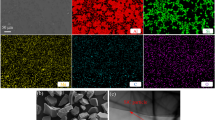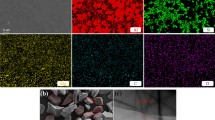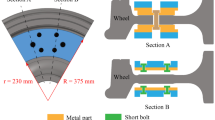Abstract
This article presents a study on the fatigue damage behavior of SiCp/A356 composites in severe service conditions of brake discs. A representative volume element (RVE) was constructed using finite element modeling technology to simulate the microstructure characteristics of the composites which takes into account the fatigue characteristics of the matrix. The RVE was loaded with local strain components and temperature histories obtained through the simulation of the braking condition of an urban rail train. The study found that the alternating effect of compressive stress and residual tensile stress at the matrix near the interface, especially at the sharp corners of SiC particles, causes fatigue damage on the matrix. Brake temperature was identified as the main factor for thermal–mechanical fatigue damage of the brake disc, and the matrix near the high-temperature position of the friction surface was found to have the highest degree of damage and the fastest failure process. The fatigue microcrack morphology and micro-failure modes inside the RVE were in good agreement with those of SiCp/A356 brake disc, and the RVE was able to characterize the micro-fatigue failure behavior of the SiCp/A356 composites under service thermal–mechanical load. This article provides a novel approach for investigating the thermo-mechanical fatigue behavior of SiCp/A356 composites from macroscopic to microscopic.

















Similar content being viewed by others
Explore related subjects
Discover the latest articles, news and stories from top researchers in related subjects.Data and code availability
All data used to support the findings of this study are included within the article.
References
Pan L, Han J, Yang Z, Wang J, Li X, Li Z, Li W (2017) Temperature effects on the friction and wear behaviors of SiCp/A356 composite against semimetallic materials. Adv Mater Sci Eng 2017:1824080. https://doi.org/10.1155/2017/1824080
Yang Z, Wang Z, Wang J, Li Z, Liu X (2021) Tribological properties of SiCp/A356 composites against semimetallic materials under dry and wet conditions. J Mater Eng Perform 30:4148–4161. https://doi.org/10.1007/s11665-021-05722-3
Chen C (2007) Research on design and manufacture of SiCp/A356 composites brake disc. MD Thesis, Beijing Jiaotong university
Djafri M, Bouchetara M, Busch C, Khatir S, Khatir T, Weber S, Shbaita K, Wahab MA (2018) Influence of thermal fatigue on the wear behavior of brake discs sliding against organic and semimetallic friction materials. Tribol Trans 61:861–868. https://doi.org/10.1080/10402004.2018.1437491
Li Z, Han J, Yang Z, Pan L (2014) The effect of braking energy on the fatigue crack propagation in railway brake discs. Eng Fail Anal 44:272–284. https://doi.org/10.1016/j.engfailanal.2014.05.022
Wang Z, Han J, Domblesky JP, Li Z, Fan X, Liu X (2019) Crack propagation and microstructural transformation on the friction surface of a high-speed railway brake disc. Wear 428:45–54. https://doi.org/10.1016/j.wear.2019.01.124
Chen NP, Zeng SM, Liu ZY (2008) Preparation, microstructures and deformation behavior of SiCP/6066Al composites produced by PM route. J Mater Process Technol 202:27–40. https://doi.org/10.1016/j.jmatprotec.2007.08.044
Wu W, Wei W, Wang Y, Sha A, Hao W (2022) Monitoring damage progression in tensile tested SiCp/Al composites using acoustic emission. Front Mater 9:918091. https://doi.org/10.3389/fmats.2022.918091
Li Z, Han J, Yang Z, Li W (2015) Analyzing the mechanisms of thermal fatigue and phase change of steel used in brake discs. Eng Fail Anal 57:202–218. https://doi.org/10.1016/j.engfailanal.2015.07.002
Meshkov VV, Zorenko DA, Barabonova IA, Afanasieva LE (2017) Transformation of 20X13 steel structure during intensive friction interactions. J Frict Wear 38:47–52. https://doi.org/10.3103/S106836661701007X
Wu Y, Liu Y, Chen H, Chen Y, Li H, Yi W (2019) Microstructure evolution and crack propagation feature in thermal fatigue of laser-deposited Stellite 6 coating for brake discs. Surf Coat Technol 358:98–107. https://doi.org/10.1016/j.surfcoat.2018.11.011
Pan L, Han J, Yang Z, Li X, Wang J, Li Z, Li W (2017) Thermal fatigue crack behavior of SiCp/A356 composites prepared by stirring casting. Results Phys 7:927–933. https://doi.org/10.1016/j.rinp.2017.02.010
Kennedy AR, Wyatt SM (2000) The effect of processing on the mechanical properties and interfacial strength of aluminium/TiC MMCs. Compos Sci Technol 60:307–314. https://doi.org/10.1016/S0266-3538(99)00125-6
Lewandowski JJ, Liu C, Hunt WH (1989) Effects of matrix microstructure and particle distribution on fracture of an aluminum metal matrix composite. Mater Sci Eng A 107:241–255. https://doi.org/10.1016/0921-5093(89)90392-4
San Marchi C, Cao FH, Kouzeli M, Mortensen A (2002) Quasistatic and dynamic compression of aluminum-oxide particle reinforced pure aluminum. Mater Sci Eng A 337:202–211. https://doi.org/10.1016/S0921-5093(02)00035-7
Smirnov SV, Konovalov AV, Myasnikova MV, Khalevitsky YV, Smirnov AS, Igumnov AS (2018) A numerical study of plastic strain localization and fracture in Al/SiC metal matrix composite. Phys Mesoch 21:305–313. https://doi.org/10.1134/S1029959918040045
Chapman NC, Silva J, Williams JJ, Chawla N, Xiao X (2015) Characterisation of thermal cycling induced cavitation in particle reinforced metal matrix composites by three-dimensional (3D) X-ray synchrotron tomography. Mater Sci Technol 31:573–578. https://doi.org/10.1179/1743284714Y.0000000582
Kurumlu D, Payton EJ, Young ML, Schoebel M, Requena G, Eggeler G (2012) High-temperature strength and damage evolution in short fiber reinforced aluminum alloys studied by miniature creep testing and synchrotron microtomography. Acta Mater 60:67–78. https://doi.org/10.1016/j.actamat.2011.09.022
Feng YC, Geng L, Li AB, Zheng ZZ (2010) Fabrication and characteristics of in situ Al12W particles reinforced aluminum matrix composites by reaction sintering. Mater Des 31:965–967. https://doi.org/10.1016/j.matdes.2009.08.021
Liu YF, Tanaka Y (2003) In situ characterization of tensile damage behavior of a plain-woven fiber-reinforced polymer-derived ceramic composite. Mater Lett 57:1571–1578. https://doi.org/10.1016/S0167-577X(02)01034-0
Velgosova O, Besterci M, Ivan J, Suelleiova K (2014) Influence of technological factors on dispersion strengthened materials deformation mechanism studied by ‘in-situ tensile test in SEM.’ Int J Mater Prod Technol 49:129–159. https://doi.org/10.1504/IJMPT.2014.064037
Gong D, Zhu M, You Z, Han H, Chao Z, Jiang L (2022) In-situ TEM study on the effect of stacking faults on micro-plasticity and proportional limit in SiC/Al composites. Compos Part B 244:110180. https://doi.org/10.1016/j.compositesb.2022.110180
Deshmukh SP, Mishra RS, Robertson IM (2010) Investigation of creep threshold stresses using in situ TEM straining experiment in an Al-5Y(2)O(3)-10SiC composite. Mater Sci Eng A 527:2390–2397. https://doi.org/10.1016/j.msea.2009.12.015
Chu D, Ma Y, Li P, Tang P (2020) Bending properties and failure mechanism of continuous W-Core-SiC fiber-reinforced 2024 and 6061 aluminum matrix composites. J Mater Eng Perform 29:6295–6306. https://doi.org/10.1007/s11665-020-05119-8
Zhang J, Ouyang QB, Guo Q, Li ZQ, Fan GL, Su YS, Jiang L, Lavernia EJ, Schoenung JM, Zhang D (2016) 3D Microstructure-based finite element modeling of deformation and fracture of SiCp/Al composites. Compos Sci Technol 123:1–9. https://doi.org/10.1016/j.compscitech.2015.11.014
Ma S, Zhang X, Chen T, Wang X (2020) Microstructure-based numerical simulation of the mechanical properties and fracture of a Ti-Al3Ti core-shell structured particulate reinforced A356 composite. Mater Des 191:108685. https://doi.org/10.1016/j.matdes.2020.108685
Zhang JF, Zhang XX, Wang QZ, Xiao BL, Ma ZY (2018) Simulations of deformation and damage processes of SiCp/Al composites during tension. J Mater Sci Technol 34:627–634. https://doi.org/10.1016/j.jmst.2017.09.005
Baek K, Shin H, Yoo T, Cho M (2019) Two-step multiscale homogenization for mechanical behaviour of polymeric nanocomposites with nanoparticulate agglomerations. Compos Sci Technol 179:97–105. https://doi.org/10.1016/j.compscitech.2019.05.006
Zhang XX, Xiao BL, Andrae H, Ma ZY (2016) Multiscale modeling of macroscopic and microscopic residual stresses in metal matrix composites using 3D realistic digital microstructure models. Compos Struct 137:18–32. https://doi.org/10.1016/j.compstruct.2015.10.045
Bouafia F, Serier B, Bouiadjra BAB (2012) Finite element analysis of the thermal residual stresses of SiC particle reinforced aluminum composite. Comput Mater Sci 54:195–203. https://doi.org/10.1016/j.commatsci.2011.10.030
Yang S, Hu W, Meng Q, Zhao B (2019) A new continuum damage mechanics-based two-scale model for high-cycle fatigue life prediction considering the two-segment characteristic in S-N curves. Fatig Fract Eng Mater Struct 43:387–402. https://doi.org/10.1111/ffe.13161
Koumpias AS, Tserpes KI, Pantelakis S (2014) Progressive damage modelling of 3D fully interlaced woven composite materials. Fatig Fract Eng Mater Struct 37:696–706. https://doi.org/10.1111/ffe.12142
Bernard F, Kamali-Bernard S, Prince W (2008) 3D multi-scale modelling of mechanical behaviour of sound and leached mortar. Cem Concr Res 38:449–458. https://doi.org/10.1016/j.cemconres.2007.11.015
Böhm HJ (2011) Continuum micromechanics of materials. Institut für Leichtbau und Biomechanik. TU Wien
Simulia (2014) Abaqus analysis user’s manual, version 6.14. Providence, RI: Dassault Systemes Simulia Corp. https://www.3ds.com/fileadmin/PRODUCTS/SIMULIA/Support/manuals/v6.14/abaqus/v6.14/HTML/
Zang J, Yang Z, Song P, Sun M, Li Z, Li C (2023) Investigating the influence of SiC particle characteristics on the mechanical properties and damage behaviors of SiCp/A356 composites. Appl Compos Mater 30:1645–1665. https://doi.org/10.1007/s10443-023-10140-w
Su YS, Ouyang QB, Zhang WL, Li ZQ, Guo Q, Fan GL, Zhang D (2014) Composite structure modeling and mechanical behavior of particle reinforced metal matrix composites. Mater Sci Eng A 597:359–369. https://doi.org/10.1016/j.msea.2014.01.024
Acknowledgements
The authors wish to acknowledge the research support grant provided by the Fundamental Research Funds for the Central Universities (2020JBZ113).
Author information
Authors and Affiliations
Contributions
JZ was involved in conceptualization, methodology, software, investigation, formal analysis, writing—original draft. ZY helped in conceptualization, funding acquisition, resources, supervision, writing—review & editing. MS contributed to data curation, validation. ZL was involved in resources, supervision. YW and SY helped in visualization, investigation.
Corresponding author
Ethics declarations
Conflict of interest
The authors declare that they have no known competing financial interests or personal relationships that could have appeared to influence the work reported in this paper.
Ethical approval
Not Applicable.
Additional information
Handling Editor: Megumi Kawasaki.
Publisher's Note
Springer Nature remains neutral with regard to jurisdictional claims in published maps and institutional affiliations.
Rights and permissions
Springer Nature or its licensor (e.g. a society or other partner) holds exclusive rights to this article under a publishing agreement with the author(s) or other rightsholder(s); author self-archiving of the accepted manuscript version of this article is solely governed by the terms of such publishing agreement and applicable law.
About this article
Cite this article
Zang, J., Yang, Z., Sun, M. et al. Simulation-based microstructural analysis of thermal–mechanical fatigue behavior in SiCp/A356 composites for brake disc applications. J Mater Sci 59, 650–668 (2024). https://doi.org/10.1007/s10853-023-09195-8
Received:
Accepted:
Published:
Issue Date:
DOI: https://doi.org/10.1007/s10853-023-09195-8




